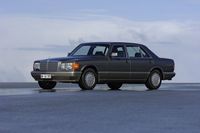Airbag Anniversary: Saving Lives for 30 Years
MULGRAVE, AUSTRALIA – Sept 27, 2010: 30 years ago, the first series-production car equipped with an airbag left the Mercedes-Benz assembly line in Sindelfingen: an S-Class Saloon. This brought to an end more than 13 years of development time for the first driver airbag at Mercedes-Benz, and a new era in vehicle safety began.
According to the US National Highway Traffic Safety Administration (NHTSA), the airbag has saved more than 28,000 human lives in the USA to date. Mercedes-Benz made the airbag available in series-production cars long before other manufacturers, and has since equipped millions of vehicles with this protective system.
Since October 1992 a driver airbag has been standard equipment in all passenger cars bearing the Mercedes-Benz star.
The fact that more and more vehicles are being equipped with life-saving airbag systems is one of the reasons for the rapid and continuous decline in the number of road accident victims in Germany.
The Federal Statistical Office has just released provisional figures for the first half of 2010: "Provisional figures show that there were 1675 road traffic fatalities in Germany from January to the end of June 2010. This was 291 or 15 percent fewer people than in the first half of 2009. This reduction is all the more remarkable because a heavy decline was already recorded in the first half of the previous year. This very positive development in the first six months of 2010 indicates that this year, we can expect the number of road traffic fatalities to fall below 4000 for the first time."
A recent study by the NHTSA in the USA examined the effectiveness of belt and airbag systems, and came to impressive conclusions: "Compared to an occupant not wearing a seat belt in a vehicle with no airbag, the statistical probability of fatal injury with an airbag and seat belt is 61 percent lower.”
In its study the NHTSA also pointed out the importance of avoiding accidents with very high collision speeds.
These are findings already known to Mercedes-Benz accident researchers
long ago, and they have therefore been part of the brand's comprehensive
approach to safety for many years:
Despite the large number of lives saved, as well as continuous improvements to these protection systems, sceptics still occasionally pose the question whether the airbag can also be dangerous. This is a question that almost brought development of the airbag to a stop in the early years: during the first tests in the early 1970s, a fatality occurred in the USA.
This caused practically all car manufacturers to cease their development efforts for the time being. Only Mercedes-Benz continued to believe in the protective effect and feasibility of airbag systems – and after intensive development work driven by a large measure of pioneering spirit, the company introduced the first mature, series-production airbags in Mercedes-Benz cars in 1980.
Numerous studies have shown the effectiveness of airbag systems since then. One such study by the NHTSA published in January 2009 documented their great life-saving potential: since their introduction, airbags have saved a total of 28,244 lives in the USA: 23,127 drivers (of whom 13,999 were not wearing a seat belt) and 5117 front passengers (of whom 2883 were not wearing a seat belt) owe their lives to the airbag.
All safety experts agree that the airbag can never be a substitute for seat belts. It is only in conjunction with a seat belt that it becomes an optimally coordinated system that demonstrably makes a major contribution to the prevention of severe or fatal injuries to the occupants during serious accidents.
This is also shown in a study conducted by the German Road Traffic Office (Bundesanstalt für Straßenwesen - BASt), which states: "During collisions with oncoming traffic, passive safety features such as airbags and seat belts mitigate the severity of the accident by a very significant 42 percent in new vehicles, compared to 14 percent for older vehicles."



